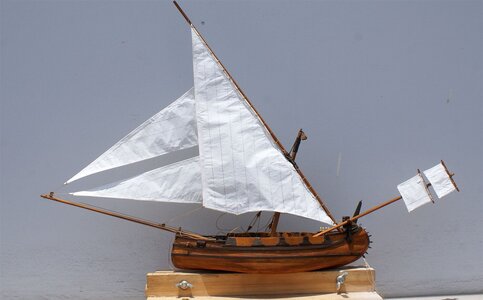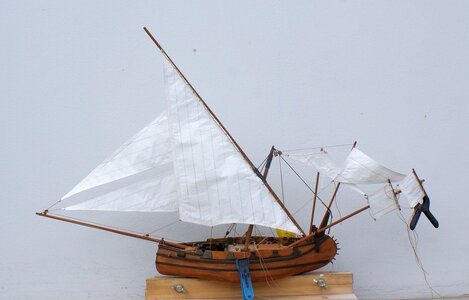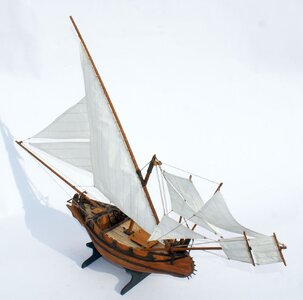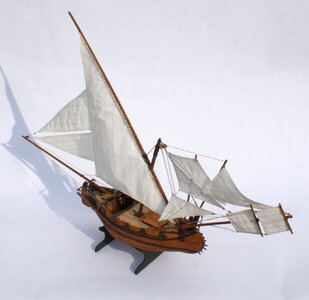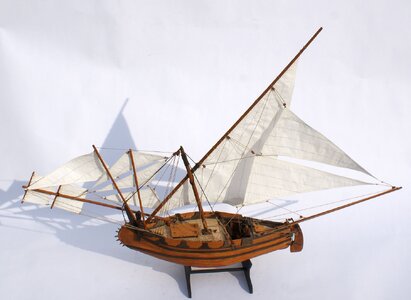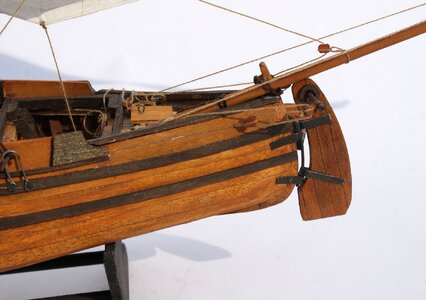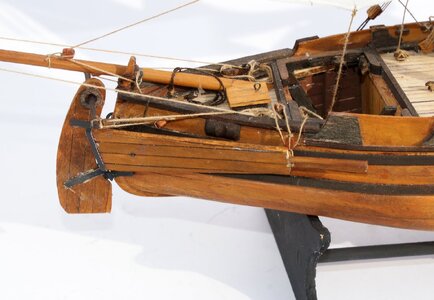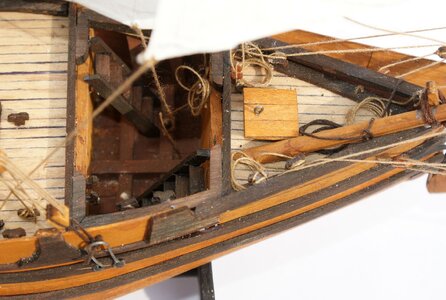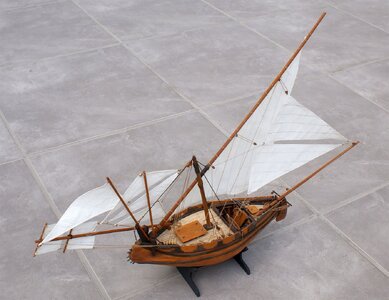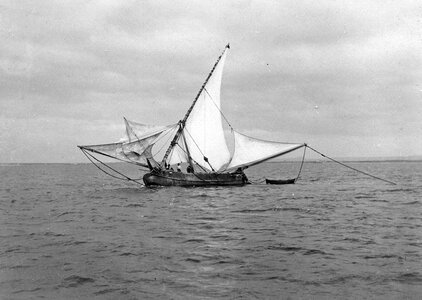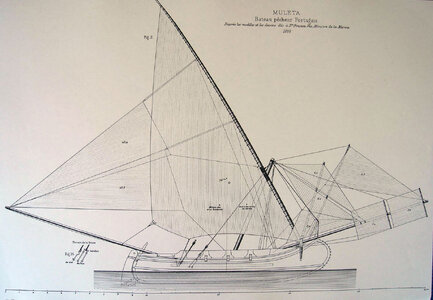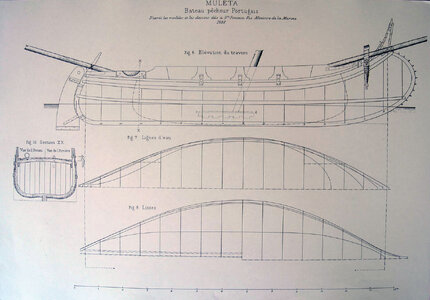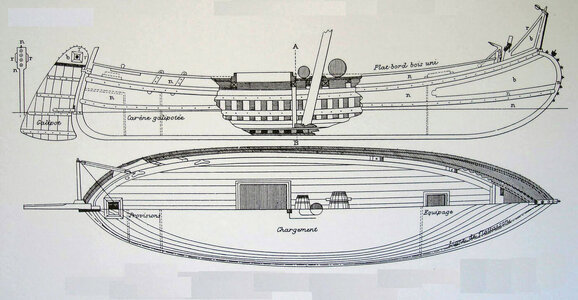To date, I have shown some scale models of my making. They are not clippers, liner ships or frigates, rather they are fishing boats or small merchant ships. In my opinion, each small boat is very unique, from its history, the shape of the hull, the rigging, the sails, its colors, the seas in which it sails and the way of sailing them, all that set of factors is what gives them that grace and uniqueness. Today I show a very special fishing boat that I made a couple of years ago. I hope you like it.
MULETA DO TEJO / SEIXAL (Part 1 of 2)
1. Introduction
The project is a "Muleta do Seixal" or "Muleta do Tejo", a boat of Portuguese origin, with a very unique hull and sails. I include parts of the Introduction and chapter 12 of the book titled "THE MULETA AND THE TARTANE (XV-XX CENTURIES)" by Fernando Gomes Pedrosa. The complete document is in the References
“The muleta, is a boat that practiced beam trawling, launching the net, called tartane, to windward, and operated by letting the wind and current carry it. In the description by A. Baldaque he says that these ships have "the sails distributed in such a way that there can be an easy compensation of forces according to the direction and the greater or lesser intensity of the wind and current", having two bows and sterns. long sticks, the bowsprit, which are used to tack and trim the sails, and at the same time their ends can be used to tie the wings of the net.”
“It was unanimously considered very ancient, of Greek, Phoenician or Norman origin. The name "muleta" would derive from the typical frame that evokes the muleta of a bullfighter. In a previously published article it was attempted to demonstrate that:
- Cross trawl fishing was practiced in France with a vessel called tartane and a net also called tartane.
- The network received the name “tartaranha” in Portugal and has been documented since the 15th century.
- The word “muleta” appeared in the 16th century as a generic name for various boats;
- In the second half of the century. XVII, some French introduced a new model of tartane in Portugal, fishing with a tartaranha net;
- The Muleta of Seixal and Barreiro is therefore not prior to the 19th century.”
“The Chapter 12 of the paper deals with the 19th century Muleta. In the engraving by João Pedroso, published in 1866, it is shown very similar to the boats of the Tagus. Also in 1866 a model was built. In summary, the Muleta since the 1700s has three characteristics that never appear in French fishing tartans: the bow and stern are raised, bending inwards; the mast leaning forward. Furthermore, the Muleta of 1772 presents two additional aspects that never appear in the tartans: that the rudder is powered by hoists and that the arch of the bow is armed with a crest of spikes. This typology is maintained in the Muletas of 1785 and 1866, except for the stern which is no longer as high. The shape of the hull, “swept bow with aggressive metallic pleating with protruding heads, very high peak, domed shapes subject to the strong contrast between the configuration of the mouth and the fineness of the slender bow and stern (…) would reflect an old Mediterranean origin "
2 References

 marintimidades.blogspot.com
marintimidades.blogspot.com

 almada-virtual-museum.blogspot.com
almada-virtual-museum.blogspot.com


 pontesnossabanda.blogspot.com
pontesnossabanda.blogspot.com

 almada-virtual-museum.blogspot.com
https://unjubiladoenlaplaya.blogspot.com/2017/03/nuevo-proyecto-muleta-barco-de-pesca.html
almada-virtual-museum.blogspot.com
https://unjubiladoenlaplaya.blogspot.com/2017/03/nuevo-proyecto-muleta-barco-de-pesca.html
The engravings and paintings show Muletas at work fishing or traveling. The uniqueness of its sails, as well as the shape of the hull and bow, is indisputable. The issue of plans has been difficult, some taken in 1888 by the French Ministry of the Navy were obtained: other plans were taken for a cardboard model published by the Polish magazine WAK; some details such as the rudder operation system, or shape of the lateral rudder, etc. were taken from articles and books (see References).
From the plans and the lines of the hull, the sections for the frames, the shape of the deck and the dimensions of the rigging were obtained. It was drawn in AutoCAD and the false keel, frames and main parts were laser cut on 4 mm and 1.5 mm plywood sheets. The dimensions of minor elements were taken to the scale of the same plans.
3 Scale model Preparation
For the hull, 2x5 mm cedar strakes were used, and a 1 mm thick piece was shaped for the board. They were then brushed and sanded to eliminate protrusions and differences between the strakes. It was sealed with a mixture of putty, sawedust and white glue, filling the joints and deficiencies of the first lining; 100, 150 and 225 sandpaper was used
0.5 mm thick veneer was cut to simulate roof decking, the slats would be 3 x 60 mm to be installed in an arrangement of 2, the edges were stained with charcoal and glued with white glue. Using a punch and the tip of a pencil, nailing was simulated. Afterwards, it was sanded with very fine sandpaper and an aged simulated with Judea bitumen. The deck was mounted on the hull, but the edges had to be adjusted by several millimeters.
For the bulwark, a 1x30 millimeter piece of wood was attached, which was shaped with heat and glued onto the first strake, then all the balsa wood filler that had been placed to allow the bulwark to be glued was removed. After the deck is fixed, the transom is placed, the characteristic element of the bow, and some crossbars. For these and other deck elements, a very dark “old” color dye will be used.
Then a coat of honey-colored wood stain was applied to the hull. 1.5x3 mm ribbons were glued, for these and other cover elements the “old” color dye was also used. The stem was drilled to embed 2 mm steel nails and simulate that unmistakable detail of the Muleta. The length and variation in diameters of the mast were measured, and the mainmast, the bowsprit and the bowsprit were prepared. In addition to the other masts, they were dyed in honey color, making the necessary perforations for the placement of blocks. The stairs to the hold, the central rudder and the side rudder were prepared.
The dimensions of the sails were taken, prepared with white paper painted on both sides with two layers of white acrylic paint, the seams were simulated with lines drawn with black pencil. The edges of the sails were reinforced with cotton thread. The sails are mounted on the rigging by means of a continuous mooring with a thick colored cotton thread; This same thread will also be used for the work rigging. We use a larger gauge thread for the lifting and fixing elements of the entena, which are cotton threads darkened and hardened with Judea bitumen. The rudders are placed, moored to the structure, and the final touches are made.


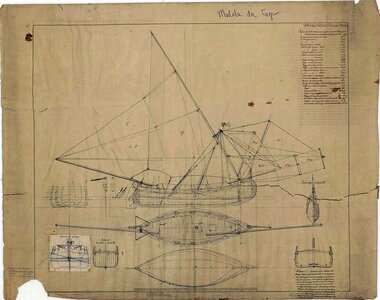


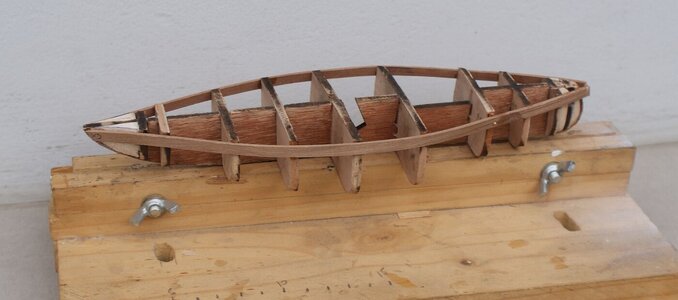
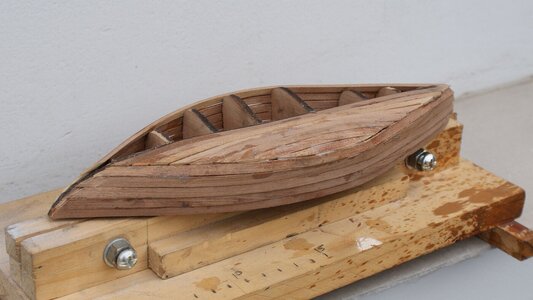
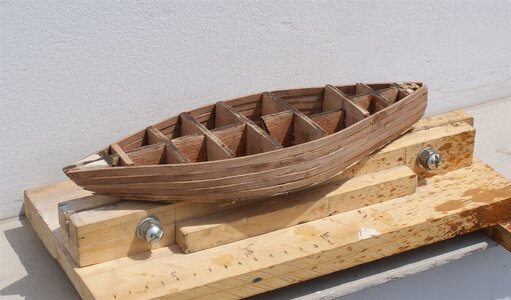
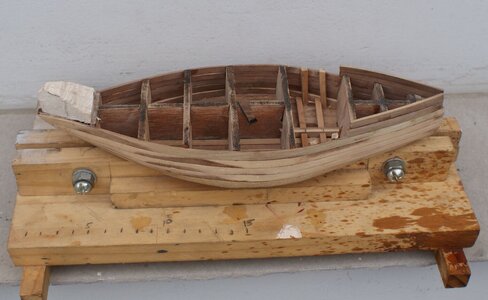
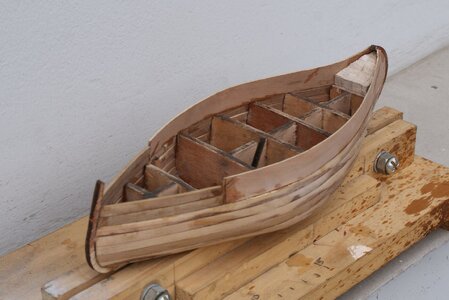
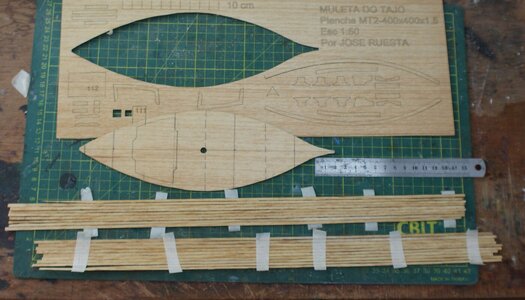

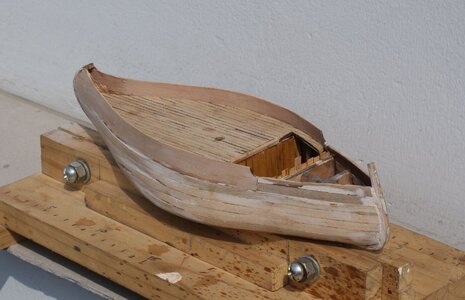
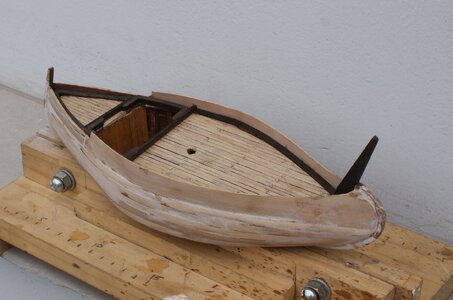
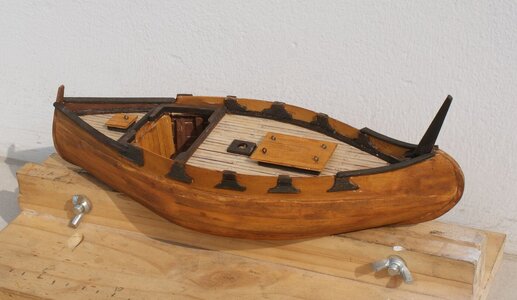
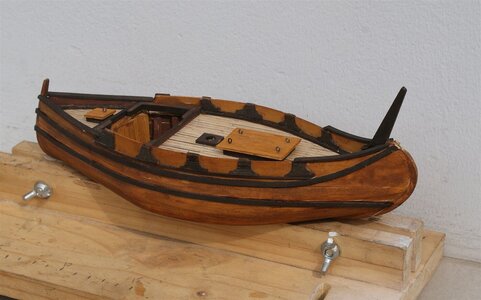
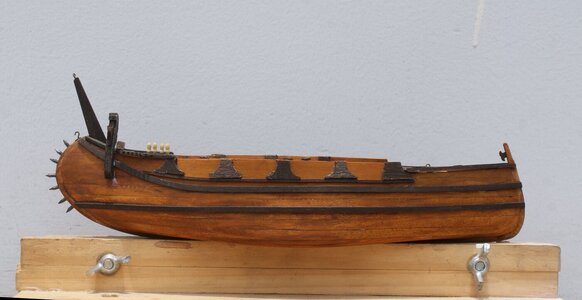
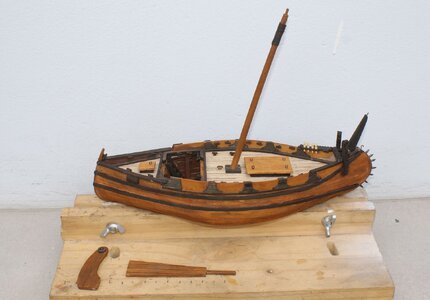
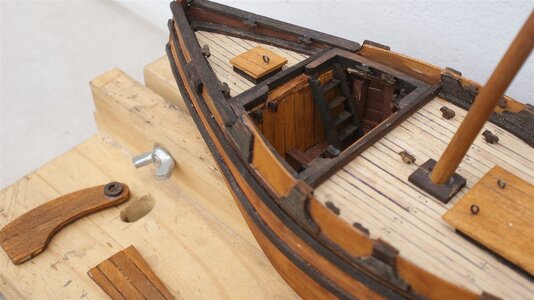
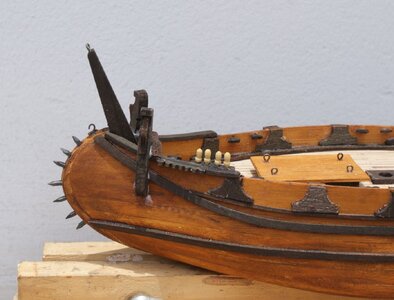

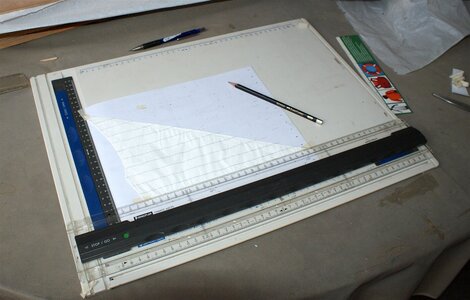
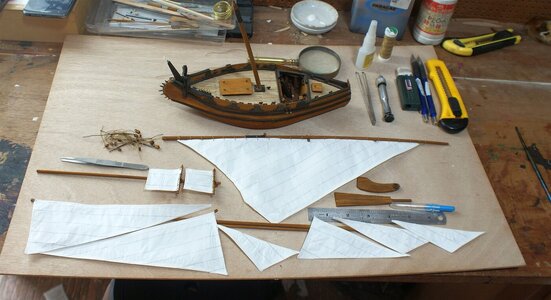
MULETA DO TEJO / SEIXAL (Part 1 of 2)
1. Introduction
The project is a "Muleta do Seixal" or "Muleta do Tejo", a boat of Portuguese origin, with a very unique hull and sails. I include parts of the Introduction and chapter 12 of the book titled "THE MULETA AND THE TARTANE (XV-XX CENTURIES)" by Fernando Gomes Pedrosa. The complete document is in the References
“The muleta, is a boat that practiced beam trawling, launching the net, called tartane, to windward, and operated by letting the wind and current carry it. In the description by A. Baldaque he says that these ships have "the sails distributed in such a way that there can be an easy compensation of forces according to the direction and the greater or lesser intensity of the wind and current", having two bows and sterns. long sticks, the bowsprit, which are used to tack and trim the sails, and at the same time their ends can be used to tie the wings of the net.”
“It was unanimously considered very ancient, of Greek, Phoenician or Norman origin. The name "muleta" would derive from the typical frame that evokes the muleta of a bullfighter. In a previously published article it was attempted to demonstrate that:
- Cross trawl fishing was practiced in France with a vessel called tartane and a net also called tartane.
- The network received the name “tartaranha” in Portugal and has been documented since the 15th century.
- The word “muleta” appeared in the 16th century as a generic name for various boats;
- In the second half of the century. XVII, some French introduced a new model of tartane in Portugal, fishing with a tartaranha net;
- The Muleta of Seixal and Barreiro is therefore not prior to the 19th century.”
“The Chapter 12 of the paper deals with the 19th century Muleta. In the engraving by João Pedroso, published in 1866, it is shown very similar to the boats of the Tagus. Also in 1866 a model was built. In summary, the Muleta since the 1700s has three characteristics that never appear in French fishing tartans: the bow and stern are raised, bending inwards; the mast leaning forward. Furthermore, the Muleta of 1772 presents two additional aspects that never appear in the tartans: that the rudder is powered by hoists and that the arch of the bow is armed with a crest of spikes. This typology is maintained in the Muletas of 1785 and 1866, except for the stern which is no longer as high. The shape of the hull, “swept bow with aggressive metallic pleating with protruding heads, very high peak, domed shapes subject to the strong contrast between the configuration of the mouth and the fineness of the slender bow and stern (…) would reflect an old Mediterranean origin "
2 References

A Muleta do Tejo
O livro A Muleta é uma edição conjunta da Câmara Municipal do Seixal/Ecomuseu Municipal e do Museu de Marinha, da autoria de Manuel Leitão,...

A muleta de pesca, por A. A. Baldaque da Silva
Um desenho bem simples e genuinamente portuguez: A muleta de pesca, deslisando á superficie das aguas, desfralda ao vento as ponteagudas vél...

[0098] Construção naval em madeira: a «Muleta» está a renascer em Sarilhos Pequenos
Fr. Nicolau de Oliveira pôde observar no rio Tejo, no início do século XVII, “ muitos barcos pequenos a que chamamos moletas ”. Mas, perto ...

Jimmy Green's, a muleta do Tejo
Muleta, embarcação de pescaria que navega na proximidade da barra de Lisboa e que, em caso de necessidade, dá piloto aos navios. (1) Mul...
The engravings and paintings show Muletas at work fishing or traveling. The uniqueness of its sails, as well as the shape of the hull and bow, is indisputable. The issue of plans has been difficult, some taken in 1888 by the French Ministry of the Navy were obtained: other plans were taken for a cardboard model published by the Polish magazine WAK; some details such as the rudder operation system, or shape of the lateral rudder, etc. were taken from articles and books (see References).
From the plans and the lines of the hull, the sections for the frames, the shape of the deck and the dimensions of the rigging were obtained. It was drawn in AutoCAD and the false keel, frames and main parts were laser cut on 4 mm and 1.5 mm plywood sheets. The dimensions of minor elements were taken to the scale of the same plans.
3 Scale model Preparation
For the hull, 2x5 mm cedar strakes were used, and a 1 mm thick piece was shaped for the board. They were then brushed and sanded to eliminate protrusions and differences between the strakes. It was sealed with a mixture of putty, sawedust and white glue, filling the joints and deficiencies of the first lining; 100, 150 and 225 sandpaper was used
0.5 mm thick veneer was cut to simulate roof decking, the slats would be 3 x 60 mm to be installed in an arrangement of 2, the edges were stained with charcoal and glued with white glue. Using a punch and the tip of a pencil, nailing was simulated. Afterwards, it was sanded with very fine sandpaper and an aged simulated with Judea bitumen. The deck was mounted on the hull, but the edges had to be adjusted by several millimeters.
For the bulwark, a 1x30 millimeter piece of wood was attached, which was shaped with heat and glued onto the first strake, then all the balsa wood filler that had been placed to allow the bulwark to be glued was removed. After the deck is fixed, the transom is placed, the characteristic element of the bow, and some crossbars. For these and other deck elements, a very dark “old” color dye will be used.
Then a coat of honey-colored wood stain was applied to the hull. 1.5x3 mm ribbons were glued, for these and other cover elements the “old” color dye was also used. The stem was drilled to embed 2 mm steel nails and simulate that unmistakable detail of the Muleta. The length and variation in diameters of the mast were measured, and the mainmast, the bowsprit and the bowsprit were prepared. In addition to the other masts, they were dyed in honey color, making the necessary perforations for the placement of blocks. The stairs to the hold, the central rudder and the side rudder were prepared.
The dimensions of the sails were taken, prepared with white paper painted on both sides with two layers of white acrylic paint, the seams were simulated with lines drawn with black pencil. The edges of the sails were reinforced with cotton thread. The sails are mounted on the rigging by means of a continuous mooring with a thick colored cotton thread; This same thread will also be used for the work rigging. We use a larger gauge thread for the lifting and fixing elements of the entena, which are cotton threads darkened and hardened with Judea bitumen. The rudders are placed, moored to the structure, and the final touches are made.



























